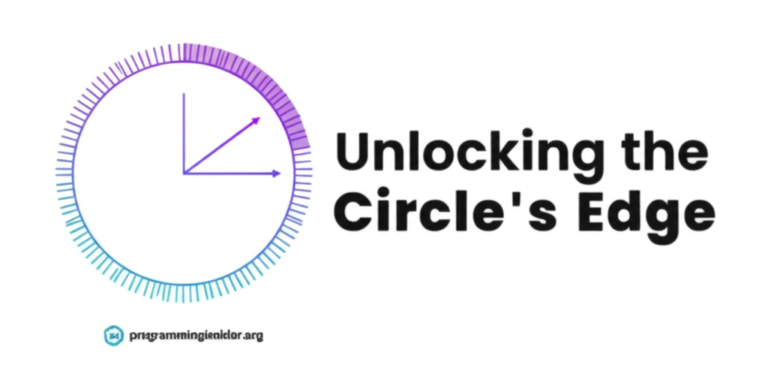What is the Circumference of a Circle?
It’s like measuring the outer boundary of a round shape in one complete loop. Ever wondered how to measure something that doesn’t have corners? The circle seems simple, yet its math is a perfect loop of wonder.
we use the formula C = 2πr or C = πd, where ‘r’ is the radius and ‘d’ is the diameter. or curious about “how to find circumference of a circle with area”, we’ll cover it all. From practical tips to expert formulas, you’ll master
How to Find the Circumference of a Circle (Made Simple)’ It’s not just math-it’s geometry in motion.The circumference wraps around the circle, and you can “find the circumference of a circle” using just one number: radius or diameter.
Need to know “how to find a circumference of a circle” for school or work? You’re in the right place.We even explain the connection between “area and circumference of a circle” in simple terms.
Want to learn “how to find the circumference of a circle” with just a few numbers?Our guide teaches you the shortcuts professionals use. Even if you only have the “area”, you can still calculate the full circle’s edge. Ready to crack the circle code? Let’s get started.
Circumference (C) = πd
Since the diameter can never be less than double the radius (d = 2r), any formula that uses a diameter can be rewritten using radius terms instead.
Circumference (C) = 2πr
“Let’s go through a few examples to make this clearer.Consider a circle whose diameter measures 10 centimeters. To find its circumference, you simply multiply the diameter by π (which is about 3.14). . Thus, 10 multiplied by 3.14 gives you a circumference of about 31.4 cm.”
But what if you only know the area and circumference of a circle isn’t immediately obvious? ” Area’ circle is with formula A = πr² But if you already know the area, you can reverse the process and figure out the radius first.” By rearranging the area formula to solve for ‘r’ (r = √(A/π)), you can then plug this value of ‘r’ into the circumference formula (C = 2πr) to find a circumference of a circle with area. This might seem like a longer route, but it’s a testament to the interconnectedness of different properties within a circle.
The concept of circumference isn’t just an abstract mathematical idea; it has countless real-world applications.”Picture a bicycle wheel rolling along the ground—each time it completes one full spin, it covers a distance equal to the length around its edge, which is the circumference of the wheel.” Engineers in the automotive and machinery industries rely heavily on precise circumference calculations for designing gears, tires, and other circular components. Even in fields like astronomy, understanding the circumference (or orbital path) of planets helps scientists calculate distances and timeframes. From the simple act of measuring around a hula-hoop to complex calculations in construction and manufacturing, the understanding of how to find a circumference of a circle is a fundamental skill.
Over time, mathematicians have developed increasingly precise methods to approximate the value of π. “Ancient civilizations came up with rough estimates for π, but it took careful mathematical work over centuries to prove that π is an irrational number—its decimal form goes on forever without repeating.” Today, computers can calculate π to trillions of digits, although for most practical purposes, using 3.14 or a more precise value like 3.14159 is usually sufficient. Understanding the circumference of a circle with diameter given or with just the radius allows us to accurately measure and work with circular objects in our everyday lives. Whether you’re figuring out how much fencing you need for a round garden or calculating the distance travelled by a spinning gear, the principles remain the same.
Visualizing Circumference
Let’s consider a few visual aids to further clarify the concept:
Figure 1: Circle with Diameter and Radius
This image shows a circle with its diameter (the longest line segment that passes through the center and connects two points on the circle) labelled as ‘d’ and the radius (the distance from the center to any point on the circle) labelled as ‘r’’-d = 2r.
Figure 2: Unwrapping the Circumference
Imagine cutting a circle at one point and then straightening it out into a line segment. The length of this line segment is the circumference. This illustration aids in grasping that the circumference is fundamentally a linear measure of the circular edge. The length of this line is consistently π times the diameter.
Figure 3: Relationship between Diameter and Circumference
This graphic illustrates that if you were to lay the diameter of a circle along its circumference, it would fit approximately 3.14 (π) times. This visually reinforces the definition of π as the ratio of the circumference to the diameter.
Conclusion
The simple formulas, C = πd and C = 2πr, derived from the fundamental constant π, provide us with the tools to accurately measure the distance around any circular object. Whether you’re calculating the amount of material needed to edge a circular garden bed or designing precision machinery, the concept of circumference plays a critical role.
FAQs:
What difference in diameter and circumference of a circle?
The circumference of a circle is always π (approximately 3.14) times its diameter.
If I know the radius of a circle, how can I find its circumference?
Find the circumference by using fC = 2πr, show ‘r’ is the radius and π is approximately 3.14.
Is there a way to calculate the circumference if I only know the area of the circle?
Yes, if you know the area (A), first find the radius using the formula r = √(A/π), and then use the circumference formula C = 2πr.
Why is the concept of circumference important in real life?
Understanding circumference is crucial in many practical applications, including engineering design (like wheels and gears), construction, measuring distances around circular objects, and even in fields like astronomy for calculating orbits.

